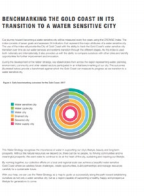case studies
Kunshan Ring Road - China
Contact
Insight:
Creation of multifunctional green corridors through integrated design of land beneath and adjacent to major elevated roads
The drivers
Kunshan has been designated by the Chinese government as a ‘sponge city’, where opportunities for water sensitive solutions are being explored The construction of an elevated Ring Road was a major opportunity for a multidimensional and multifunctional green corridor
- Kunshan is a polder city (a piece of land in a low-lying area that has been reclaimed from a body of water by building dikes and drainage canals) with many canals and waterways which can have poor water quality in some areas.
- An overarching ecosystems services framework was developed which aims to embed water, forest, food and culture into a mosaic of open spaces across the city. An inner ring ecological corridor was proposed to restore existing waterways while an outer ring ecological corridor was proposed to be created along the Ring Road corridor. These two corridors will link open spaces and provide city-wide connectivity.
- As a designated ‘sponge city’, Kunshan is a hub for technologies and techniques that promote infiltration, greening and integrated water management. This designation gives focus to opportunities in the city and has been supported by the input from various researchers including the CRC for Water Sensitive Cities.
• The Ring Road (elevated road bridge) was proposed to support the urban growth in Kunshan. As the road would have a major influence on the urban design of the city, local authorities wanted to explore opportunities to enhance amenity and ecological functionality.
• The Ring Road crosses many canals, so there were opportunities to construct wetlands at various locations along the road land to treat canal water and contribute to the overall water quality management strategy for the city.
The innovations
Integrated design of a city-wide parkland corridor
- Multifunctional landscapes — This project has been designed to support both water quality treatment and enhance amenity within an urban setting by designing a road corridor that is multidimensional and multifunctional.
- Road stormwater treatment — Utilising water sensitive urban design techniques, such as raingardens and constructed wetlands for water treatments, the Ring Road project provides immediate treatment to stormwater runoff from bridge surfaces, improving water health of receiving water bodies.
- Polder water treatment — Polder water is recirculated through constructed wetlands for greater waterway health.
- Ecological system of nodes and links — Parklands are designed and constructed at specific spots along the Ring Road, creating urban green spaces for local communities.
- Use of shade tolerant plants in bioretention systems — Shade tolerant plants are selected for the bioretention systems under the Ring Road bridge.
Project stats
Location
Kunshan, Jiangsu Province, China
Dates
August 2019
Participants
Contact
The outcomes
 Cities providing ecosystem services
Cities providing ecosystem services

- Ecological network — The Ring Road crosses many canals. With many nodal parklands along the Ring Road, it creates an integrated ecosystem resilient to climate change.
- Species enrichment — Emergent plants and swamp forests which are less commonly seen in an urban environment are introduced to enhance landscape along the Ring Road.
- Self-maintenance — Once reaching system balance, the ecological system can achieve self-maintenance with minimal maintenance costs.
 Cities as water supply catchments
Cities as water supply catchments

- Improved water resources — Raingardens and constructed wetlands are used to provide immediate stormwater treatment, improving the health of receiving water bodies and canals.
 Cities comprising water sensitive communities
Cities comprising water sensitive communities

- Sense of place — Nodal parks provide aesthetic destinations for spiritual and recreation activities for local communities.
- Community interaction with WSC — Nodal parks are popular with the local community, providing opportunities for them to interact with water sensitive cities design.
Interested in this solution?
We partner with small and large companies, government and industry in Australia and around the world.



Comments